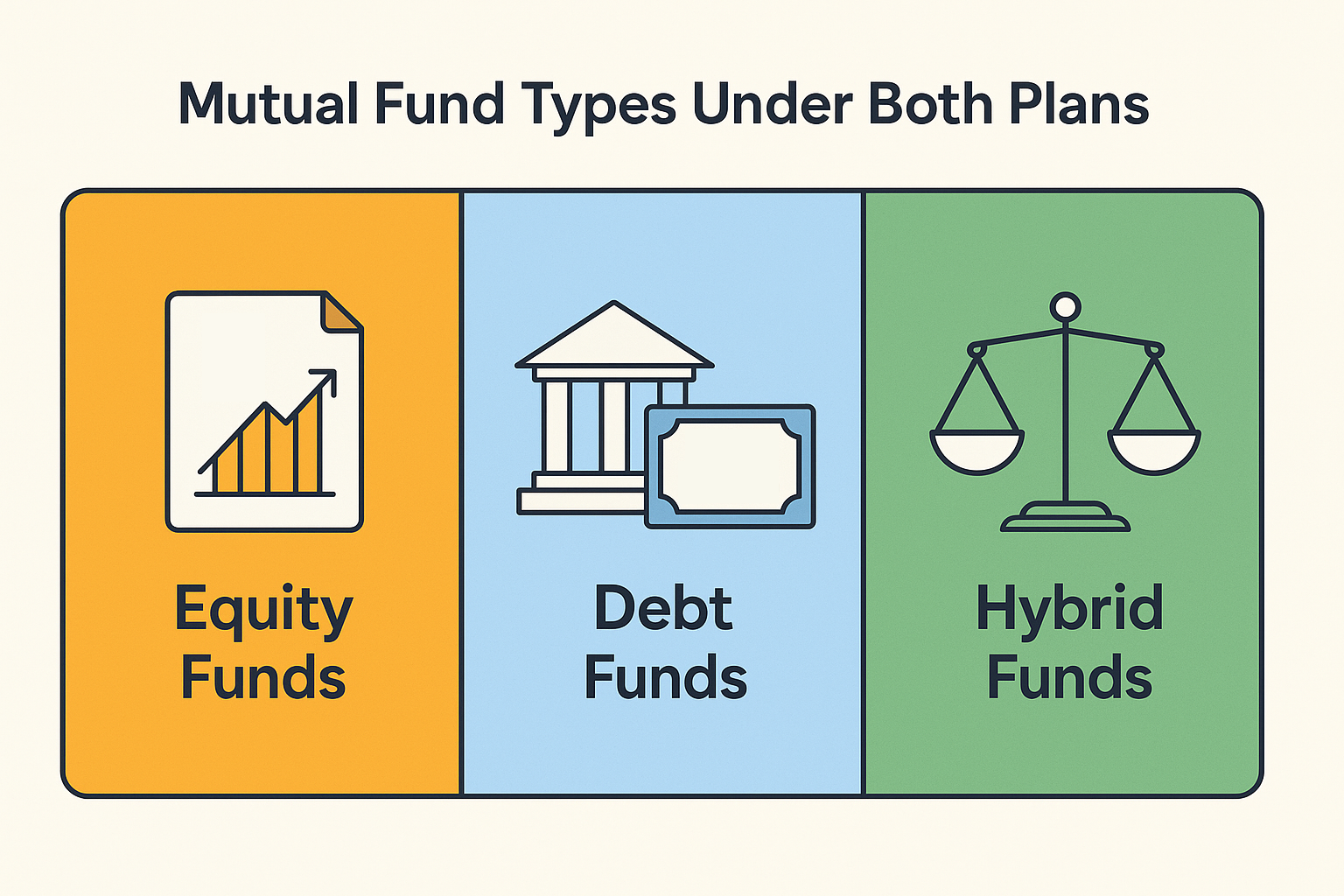Regular vs Direct Mutual Funds:
When investing in mutual funds, one of the first decisions you’ll need to make is choosing between a Regular Plan and a Direct Plan. While both options invest in the same mutual fund scheme, they differ significantly in cost structure, returns, and investment approach.
Understanding the difference between the two can help you make an informed choice aligned with your financial goals, experience level, and comfort with managing investments.
What Are Regular and Direct Mutual Funds?
Regular Mutual Funds
These are purchased through intermediaries like mutual fund distributors, brokers, or financial advisors. While they offer guidance and handholding, they also come with a higher expense ratio due to commission-based fees paid to intermediaries.
Direct Mutual Funds
You invest directly with the fund house — either via their website or apps — without involving any intermediary. As a result, the expense ratio is lower, and over time, you benefit from higher returns. However, you are responsible for tracking, managing, and making all investment decisions yourself.
Key Differences Between Regular and Direct Mutual Funds
| Feature | Regular Mutual Fund | Direct Mutual Fund |
|---|---|---|
| Purchased Through | Intermediary (broker, distributor, advisor) | Directly from AMC (Asset Management Company) |
| Expense Ratio | Higher due to commissions | Lower, no middlemen involved |
| Returns | Slightly lower due to fees | Higher over long-term due to cost savings |
| NAV | Lower (due to higher expenses) | Higher (same fund, lower cost) |
| Convenience | Advisor manages most things for you | Requires self-management and research |
| Best Suited For | Beginners, busy professionals | Experienced, cost-conscious investors |
How to Invest in Regular and Direct Plans
Investing in Regular Plans:
-
Meet a distributor or advisor.
-
Complete your KYC (Know Your Customer).
-
Start investing through their platform — online or offline.
-
SIPs (Systematic Investment Plans) usually start at ₹500/month.
Investing in Direct Plans:
-
Visit the fund house’s official website or trusted investment platforms.
-
Complete your KYC online.
-
Start SIPs from as low as ₹500/month.
-
You’ll need to track and manage your investments yourself.
Which Plan Suits Which Investor Profile?
New Investors
If you’re just getting started, a Regular Plan may be more suitable. The advisor can help you choose the right funds and avoid costly mistakes.
Experienced Investors
Comfortable with financial jargon, asset allocation, and market trends? Go for Direct Plans — you’ll save on fees and maintain control.
Busy Professionals
If time is limited and managing a portfolio sounds overwhelming, Regular Plans offer value through advisory support and convenience.
Types of Mutual Funds Under Both Plans

Whether you choose Direct or Regular, you can invest in:
-
Equity Funds: High-risk, high-reward; best for long-term wealth building.
-
Debt Funds: Lower-risk, stable returns; ideal for conservative or short-term investors.
-
Hybrid Funds: Balanced approach combining equity and debt; great for moderate risk-takers seeking diversification.
Risks You Should Know
-
Market Risk: Particularly relevant in equity funds; value may fluctuate with market conditions.
-
Advisor Bias: In Regular Plans, advisors may recommend funds with higher commissions.
-
Self-Directed Risk: In Direct Plans, poor research or lack of knowledge can lead to bad investment choices.
Tax Implications: Regular vs Direct
Tax treatment is identical for both plans. The difference lies in your net returns, as Direct Plans offer more cost-efficiency.
Equity Funds:
-
LTCG (Long Term Capital Gains): 10% tax over ₹1 lakh (after 12 months).
-
STCG (Short Term Capital Gains): 15% tax (before 12 months).
Debt Funds:
-
Taxed as per your income tax slab (indexation benefit removed from April 2023).
Regular vs Direct Plans for Financial Goals
Short-Term Goals
Use Regular Plans in Debt Funds — an advisor can help you time your entry and exit efficiently.
Long-Term Goals
Opt for Direct Plans in Equity Funds to benefit from compounding and lower expenses over time — ideal for retirement or children’s education.
Strategies to Select the Right Plan
-
Beginner? Start with Regular Plans. Learn the basics with guidance, then transition to Direct as you gain confidence.
-
Cost-Sensitive? Go Direct for long-term SIPs.
-
Mix It Up: Use Regular for complex strategies and Direct for straightforward options like Index Funds.
-
Goal-Oriented Investing: Match the plan with your investment horizon and risk appetite.
Final Thoughts: Which One is Right for You?
Choosing between Regular and Direct Mutual Fund plans depends entirely on your financial literacy, time availability, and investment comfort level.
-
If you value expert advice and are still learning, Regular Plans may be the better option — despite the higher fees.
-
If you’re cost-conscious, informed, and confident in handling your portfolio, Direct Plans can help you maximize returns over time.
Whichever path you choose, the key is to stay disciplined, review your investments periodically, and align them with your long-term financial goals.
Want to start investing?
Begin with a plan that matches your profile — and remember, every percent saved in costs compounds into wealth over time.
![]()



